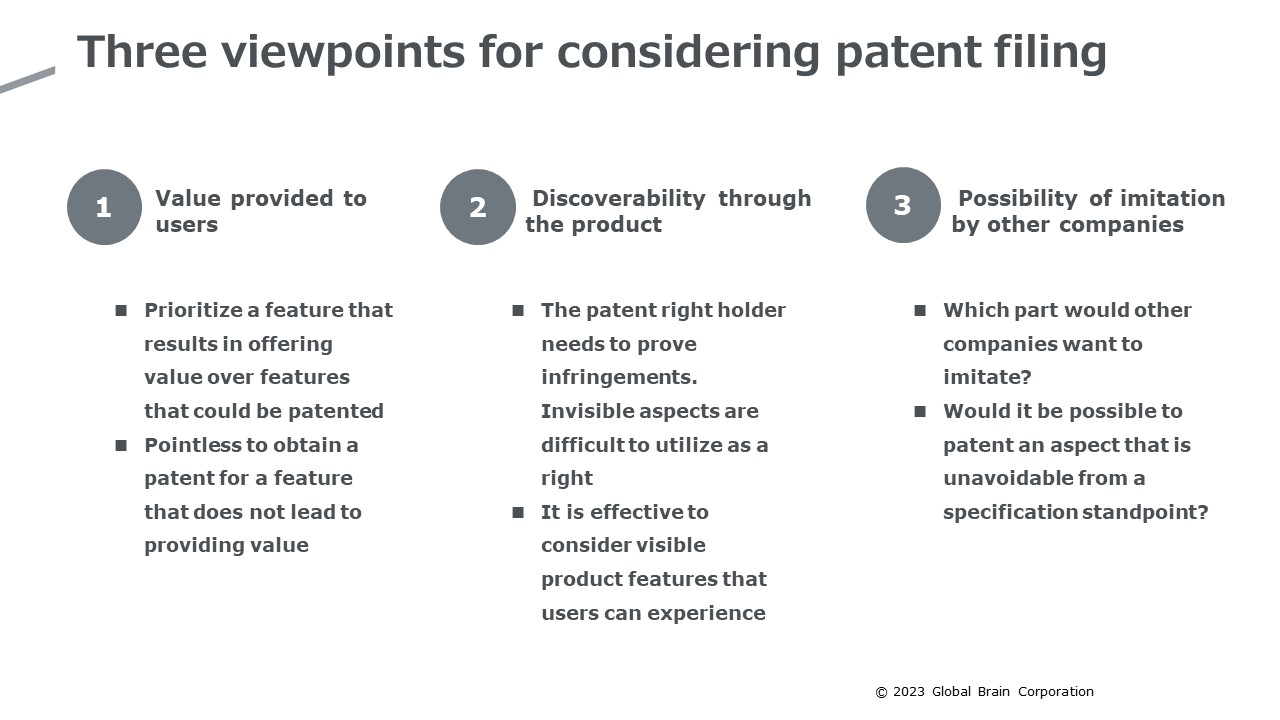Three Perspectives for Startups to Adopt When Considering Patent Filing
This article introduces what to consider for possible patent filing.

Written by Shohei Hirota
Three Viewpoints for Considering Patent Filing
When considering patent filing, I organize the details from the following three viewpoints: (1) Which part provides value to the users?, (2) Is the value visible from product users?, and (3) Would other companies want to imitate it? Using the case examples we saw in the previous article, we will look at each of these points.

1. Which Part Provides Value to the Users?
It is vital to think from the standpoint of product users and customers. This may sound obvious, but it is often the case that obtaining a patent becomes the goal when you focus too much on identifying the features that could be patented.
It would be pointless to hold a patent right of a feature that does not provide much value to the users. It is important to consider which part of the product or service provides new value to the customers and whether it can be patented.
New value offered by Findy was visualizing engineers’ skills that are difficult for HR departments, etc. to assess (JP6837699). Luup’s new value is how it enables users to reserve a parking area so that they will not arrive at their destination only to find it full (JP6785021). The point here is that both companies have protected these aspects with patents.
2. Is It Visible to Product Users?
The burden of proof lies with the patent right holder, which means that patent rights can only be exercised when the patent right holder proves infringements by other companies. Accordingly, it is crucial to obtain patent rights for "visible aspects.” For example, when Apple exercised its rights against Samsung, it used a number of patents related to the UI, which is visible to everyone. From this perspective, it is also important to consider patents on product aspects that are visible.
SmartBank patented the user experience (JP7195031) where users pair with each other when issuing pair cards, and UPSIDER patented its function to combine payment limits of multiple cards for bill payment. Both companies have patented aspects that are visible to product users.
If a patent is obtained on a noticeable feature that users can experience, it will relatively be easier to identify whether the patented technology is used for a certain product/service just by using it and also to prove infringements.
3. Would Other Companies Want to Imitate It?
The essence of intellectual property is to prevent others from copying your product without your permission. It is also vital to consider which aspect of the product other companies would want to imitate as well as which aspect is indispensable and must be imitated if they tried to provide a similar product.
SmartBank’s patent on pair cards, as mentioned above, covers the flow of pairing users and issuing cards. Since card issuance is an essential part of payment services, this is what other companies would want to imitate when they try to offer pair cards.
UPSIDER also provides user companies with “shiharai.com” which allows them to pay bank transfer invoices with credit cards to improve cash flow. When a user tries to pay a large amount with a credit card to improve cash flow, the card’s payment might reach its limit. UPSIDER has patented its feature which enables users to combine credit limits of several cards when paying invoices (JP7148852). Other companies would want to imitate this feature if they wanted to attract their customers to use their own services for large invoices.
Summary
This article has highlighted the three viewpoints to consider for patent filing. Satisfying these three points does not necessarily mean that you would succeed in obtaining a patent. As patents are there to protect new technologies or ideas, it is impossible to obtain a patent if a similar product or a preceding patent already exists. Therefore,it is vital to have an expert such as a patent attorney research and study this point. If you find an aspect you would like to file a patent for based on the viewpoints (1) to (3), we recommend you consult with an IP expert.
In the next article, we will look at the bigger picture and share with you the "Goal Setting and Three Phases for Startups’ Intellectual Property Strategy.”

Shohei Hirota
Investment Group
Director
Patent & Trademark Attorney
Shohei joined GB in 2020. He launched the intellectual property (IP) team and is responsible for IP-related due diligence and support for portfolio startups.